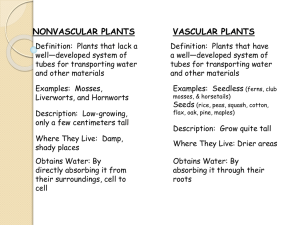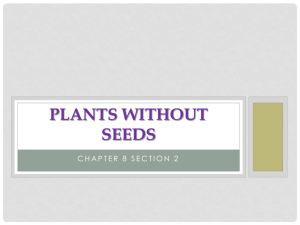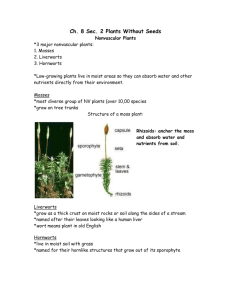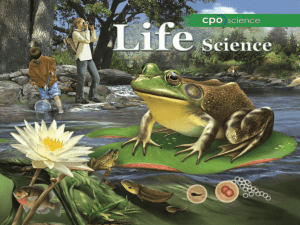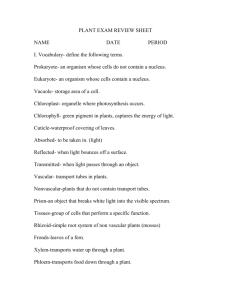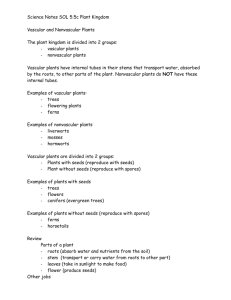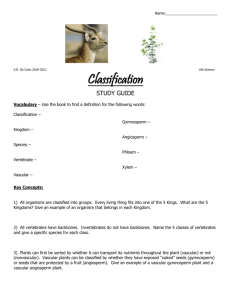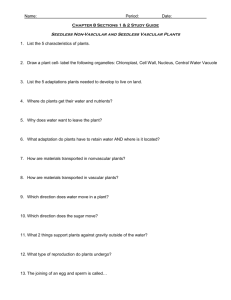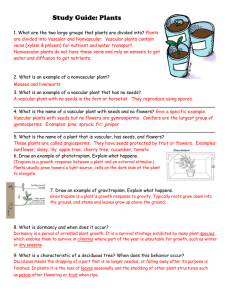PLANTS!
advertisement
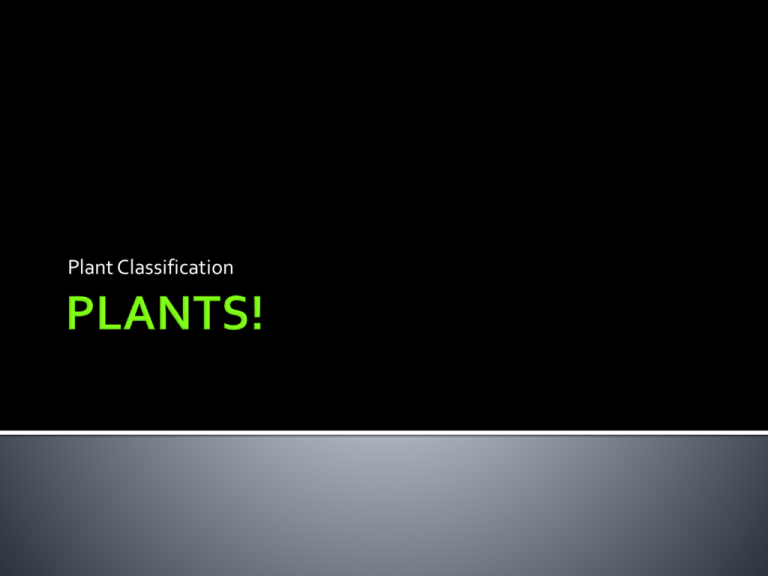
Plant Classification Characteristics: 1. Live in MOIST environments • 2. WHY? Absorb WATER and NUTRIENTS from their environment • NO vascular tissue! (thin cell walls) Examples: 1. Mosses • Gametophyte is green and fuzzy • Sporophyte is long and slender with capsule at the end • Peat moss is used in agriculture and gardening • Peat is used as fuel 1. Liverworts • Found on Moist Rock and Soil beside streams Examples: 1. Hornworts • Found in Moist Soils Drawing: Label: Sporophyte Capsule Stalk Gametophyte Stemlike structure Leaflike structure Rhizoids Characteristics: 1. Have vascular tissue- system of tubelike structures inside a plant that water, minerals, and food move through 2. Do NOT produce seed-reproduce with spores 3. Live in moist surroundings so sperm can swim to eggs Examples: 1. Ferns • Size range is small to 5 meters tall! • Fronds are FERN LEAVES How are club mosses different from “true” mosses? Examples: 1. Club Mosses • Grow on moist woodlands near streams Examples: 1. Horsetails • Steams are jointed Drawing: Label: Frond Spores Stem Roots On a piece of paper draw the Venn Diagram below. Include: •2 Similarities between Nonvascular and Seedless Vascular Plants •2 Differences between Nonvascular and Seedless Vascular Plants Nonvascular Seedless Vascular 1. 1. 1. 2. 2. 2. Characteristics: 1. Seed plant that produce Naked Seeds 2. Have needle-like or scale-like leaves and deep growing roots Examples: 1. Cycads- palm trees with cones 2. Conifers- Cone bearing plants; aka Evergreens because they keep their leaves year-round 3. Ginkgoes- Ginkgo biloba 4. Gnetophytes- live in hot desert and tropical rainforest Look like Palm trees with cones •Cone Bearing Plants •Evergreens (keep leaves year-round) Only ONE species: Ginkgo biloba Live in hot deserts and tropical rainforests Use POLLEN and SEEDS to reproduce! The scattering of seeds so they are away from the parent plant. 1. What are some ways that seeds are dispersed? 2. What are the 3 parts of a seed? Characteristics: 1. Produce flowers 2. Seeds are enclosed in fruits Characteristics: 1. FLOWER • Reproductive structure of an angiosperm Characteristics: 1. FRUIT • Ripened ovary and other structures that enclose one or more seeds • http://www.youtube.com/watch?v=sEwmUbzN_-g (Fruit Development) • Dandelion (http://www.youtube.com/watch?v=UQ_QqtXoyQw) Plant Part MONOCOT DICOT Seed One cotyledon 2 cotyledons Leaf Parallel veins Branching veins Stem Bundles of vascular tissue scattered Bundles of vascular tissue arranged in a ring Flower Parts in 3 Parts in 4 or 5 Example Tulip, Grass, Wheat, Corn Roses, Violets, Dandelions 1. Tulips 2. Grass 3. Wheat 4. Corn 1. Roses 2. Violets 3. Dandelions http://www.ted.com/talks/louie_schwartzberg_the_hidden_beauty_of_pol lination.html POLLEN OVARY (LABEL OVULE) 100x
